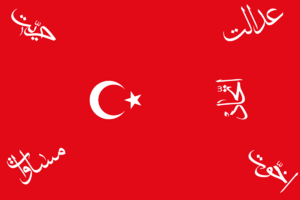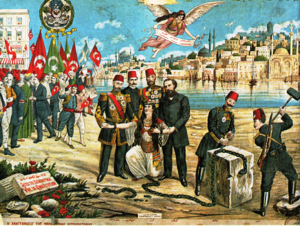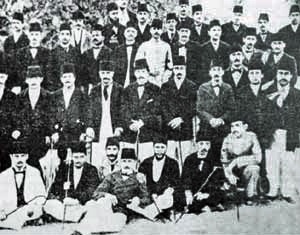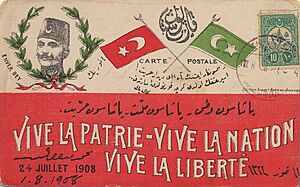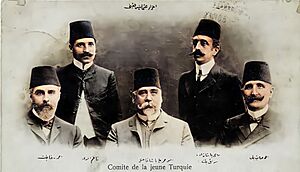Young Turks facts for kids
The Young Turks were a group of people who wanted to change the way the Ottoman Empire was ruled in the early 1900s. They wanted to replace the absolute monarchy (where one ruler has all the power) with a constitutional monarchy (where a ruler shares power with a government chosen by the people).
In 1908, they led a rebellion against Sultan Abdulhamid II. This event is known as the Young Turk Revolution. Because of this revolution, the Ottoman Empire started a new period called the Second Constitutional Era. This was the first time the country had a multi-party democracy, meaning many different political groups could take part.
Sultan Abdulhamid II had previously promised a constitution and a parliament. But by 1878, he closed the parliament and went back to ruling alone. He used a secret police to stop people from disagreeing with him. He also allowed terrible events against minority groups. People who wanted a constitution, like Prince Sabahaddin and Ahmet Rıza, became known as the Young Turks. Even though they were called "Turks," the group included many Arabs, Albanians, Jews, and at first, Armenians and Greeks.
To organize their efforts, some medical students like Ibrahim Temo and Abdullah Cevdet formed a secret group. This group was first called the Committee of Ottoman Union. Later, it became known as the Committee of Union and Progress (CUP). Many exiles, government workers, and army officers joined them. In 1908, officers who supported the CUP marched into Istanbul. They forced Sultan Abdulhamid II to bring back the constitution. Later, an attempt to overthrow the new government failed, and Abdulhamid II was removed from power.
The Young Turks were a mix of thinkers and revolutionaries. They all wanted to end Abdulhamid's absolute rule and bring back the constitution. After the revolution, the Young Turks split into different groups. Some were more liberal and wanted less central control. Others, like the main part of the Committee of Union and Progress, were Turkish nationalists who wanted a strong central government. This power struggle continued until 1913. After the Grand Vizier (prime minister) Mahmut Şevket Pasha was killed, the CUP took full control. The new CUP leaders, known as the Three Pashas, created a one-party state. They had complete control over the Ottoman Empire. They also led the Empire into World War I on the side of the Central Powers. During this time, the CUP government also planned and carried out terrible acts against some minority groups as part of their plan to make everyone more "Turkish."
After World War I, the other Young Turk groups briefly regained control. They tried to remove the CUP members from power. But their rule didn't last long. With Mustafa Kemal Pasha (Atatürk) leading a nationalist movement in Anatolia, the Ottoman Empire soon fell apart.
Today, the term "Young Turk" is sometimes used to describe a new, energetic person who tries to take control of a situation or group.
Contents
History of the Young Turks
How the Young Turks Began
The Young Turks were inspired by a political movement in Italy called "Young Italy." Their movement started with secret groups of "progressive medical students and military cadets." These groups, like the Young Ottomans, had to go underground. This happened after Sultan Abdulhamid II ended the First Constitutional Era in 1878. This era had lasted only two years. The Young Turks wanted to bring back the Ottoman Parliament and the 1876 constitution. This constitution was written by a reformer named Midhat Pasha.
Meetings of the Ottoman Opposition
The first meeting of the Ottoman opposition was held on February 4, 1902, in Paris, France. Forty-seven delegates attended this secret meeting.
A second meeting of the Ottoman opposition took place in Paris in 1907. Leaders like Ahmed Rıza, Sabahaddin Bey, and Khachatur Malumian were there. Their goal was to unite all groups, including the Young Turks' Committee of Union and Progress, to start a revolution and bring back the constitution.
The Revolution of 1908
By 1906, the Young Turks became a well-organized movement under the Committee of Union and Progress (CUP). They recruited people who wanted a constitutional monarchy in the Ottoman Empire. A group called the Ottoman Freedom Society (OFS) was formed in Thessalonica by Mehmed Talaat. The OFS actively recruited members from the army, including Major Ismail Enver. In 1907, the OFS joined with the CUP, and its leaders gained much control over the CUP.
In 1908, the Ottoman Empire faced problems in a region called Macedonia. Other European countries wanted to control parts of this area. On May 13, 1908, the CUP leaders sent a strong message to Sultan Abdulhamid II. They warned him that the royal family would be in danger if he did not bring back the 1876 constitution. On June 12, 1908, the army in Macedonia began marching towards the Sultan's palace in Constantinople. Although Abdulhamid did not want to give up his power, he was forced to restore the constitution on July 24, 1908. This marked the start of the Second Constitutional Era in the Ottoman Empire.
The Second Constitutional Era
During this new era, the Young Turks held their first public meeting in Salonica in late 1911. They announced plans to disarm Christians and prevent them from buying land. They also wanted to settle Muslims in Christian areas and make all Ottoman citizens "Turkish." This could be done by convincing them or by force.
The unity among the Young Turks began to break apart. This was especially true as the Ottoman Empire started to dissolve, and the Balkan Wars began in 1912. By 1913, the CUP banned all other political parties, creating a one-party state. The Ottoman Parliament became a mere formality, and all important decisions were made by the CUP's Central Committee.
World War I
On November 2, 1914, the Ottoman Empire joined World War I on the side of the Central Powers. The Young Turks, after being turned away by other European powers, secretly allied the Ottoman Empire with Germany. They needed to improve the Empire's communication and transportation systems. But they did not want to rely on European bankers, who already controlled much of the country's railroads and its foreign debt. During the war, the Young Turk empire was very weak economically.
At the end of the war, the CUP leaders Talaat Pasha, Enver, and Cemal resigned and fled into exile. The Ottoman Empire signed an agreement to stop fighting on October 13, 1918.
Forced Displacement of Armenians (1915–1918)
The conflicts during World War I, especially in the Caucasus and Gallipoli, affected areas where many Armenians lived. The Ottoman government saw Armenians as a potential threat who might support Russia in the war. To remove this perceived threat, the Ottoman government began a large-scale forced movement of Armenians.
Jakob Künzler, who ran a hospital, wrote about the large-scale forced displacement of Armenians and Kurds. He described how Armenians were forced to move from areas like Erzurum and Bitlis in 1916. Around 300,000 Armenians were forced to move south and then west. Later, in 1917, Armenians were moved to central Anatolia. The CUP leaders aimed to remove the Armenian threat by moving them from their homes and spreading them out in small groups. By the end of World War I, up to 1,200,000 Armenians were forcibly moved from their home regions. About half of these people died from exposure to harsh conditions, hunger, and disease. Others were victims of attacks or forced labor.
At first, Armenians saw the CUP as allies. But during World War I, the CUP's growing nationalism led them to take part in these terrible events. In 2005, the International Association of Genocide Scholars stated that evidence shows the CUP government "began a systematic genocide of its Armenian citizens and unarmed Christian minority population. More than a million Armenians were exterminated through direct killing, starvation, torture, and forced death marches."
Ideas of the Young Turks
The Young Turks wanted to change their society so that religion played a smaller role. This was a big change from the religious rule of the Ottoman Empire. However, they soon realized it was hard to spread this idea among the very religious people. So, they tried to suggest that Islam itself was modern.
They were also very impressed by Positivism, a philosophy that sees science as the main way to understand the world. They believed this could be combined with Islam more easily than other ideas. The name of their group, Committee of Union and Progress, is thought to be inspired by the positivist thinker Auguste Comte's motto: Order and Progress. Positivism also supported their idea of a strong government.
After the CUP took power in 1913, they tried to make the Empire's government more centralized. This meant more power would be held by the central government. Many of the original Young Turks disagreed with this idea. They had formed other parties that opposed the CUP's centralization plans.
At first, the Young Turks supported Ottomanism, an idea that all people in the Ottoman Empire, no matter their background, were Ottomans. But this idea did not work well. Many non-Turkish thinkers rejected it. Over time, Turkish nationalists gained more power. After a meeting in 1902, Ahmed Rıza started using the term "Turk" instead of "Ottoman." This shifted the focus from Ottoman unity to Turkish nationalism.
Important Young Turks
Some of the key leaders and thinkers included:
- Writers and Activists
* Tunalı Hilmi * Yusuf Akçura, a journalist who supported a secular (non-religious) national identity. * Osman Hamdi Bey, an Ottoman-Greek painter. * Emmanuel Carasso Efendi, a lawyer. * Mehmet Cavit Bey, who was the Minister of Finance. * Abdullah Cevdet, a Kurdish thinker who supported secularism. * Marcel Samuel Raphael Cohen (also known as Tekin Alp), who helped create Turkish nationalism. * Agah Efendi, who started the first Turkish newspaper. * Ziya Gökalp, a Turkish nationalist and early sociologist. * Talaat Pasha, whose role became very important after the revolution. * Ahmed Riza, who worked to improve the lives of farmers and later served as a minister.
- Military Officers
* Ahmed Niyazi Bey, a leader of the Young Turk Revolution. * Enver Pasha, another key leader of the revolution and a major politician. * Eyüp Sabri, a leader of the Young Turk Revolution. * Bekir Fikri, who took part in the Young Turk Revolution. * Atıf Kamçıl, a participant in the Young Turk Revolution.
See also
 In Spanish: Jóvenes Turcos para niños
In Spanish: Jóvenes Turcos para niños


